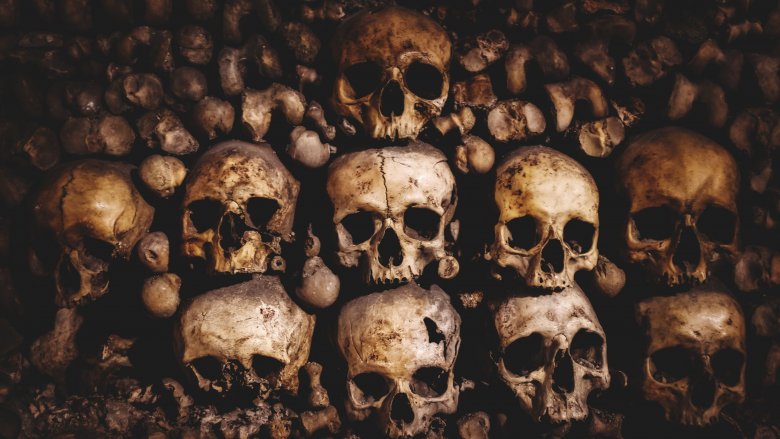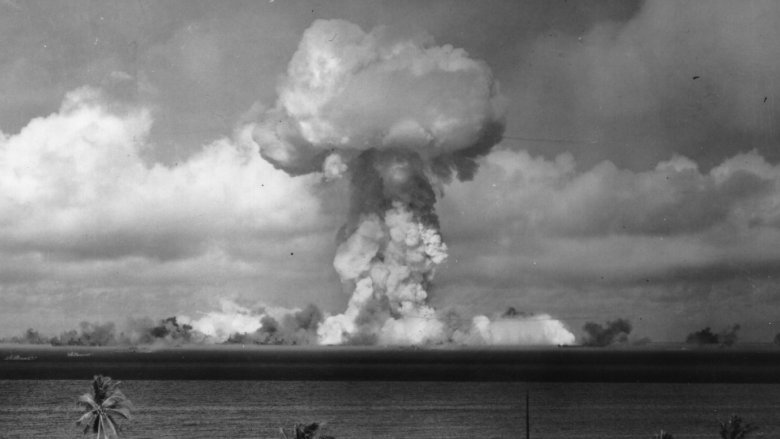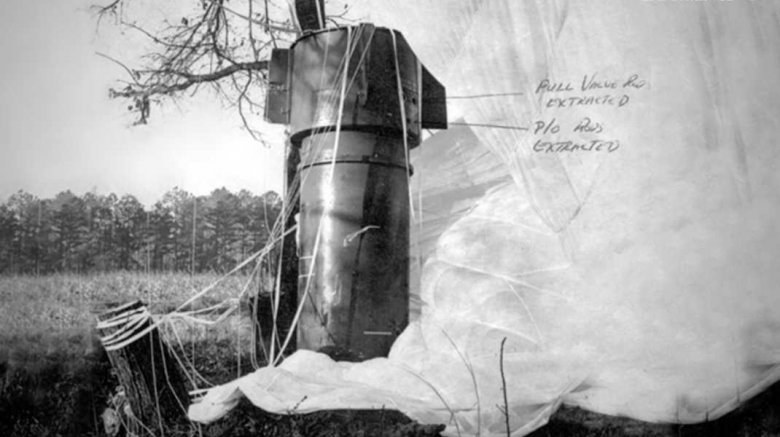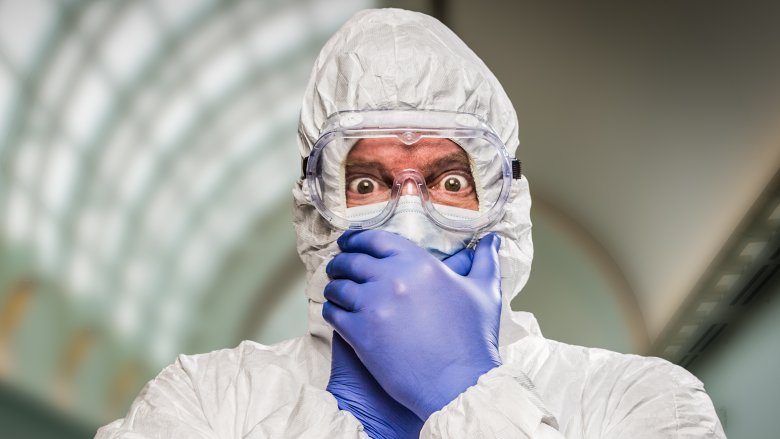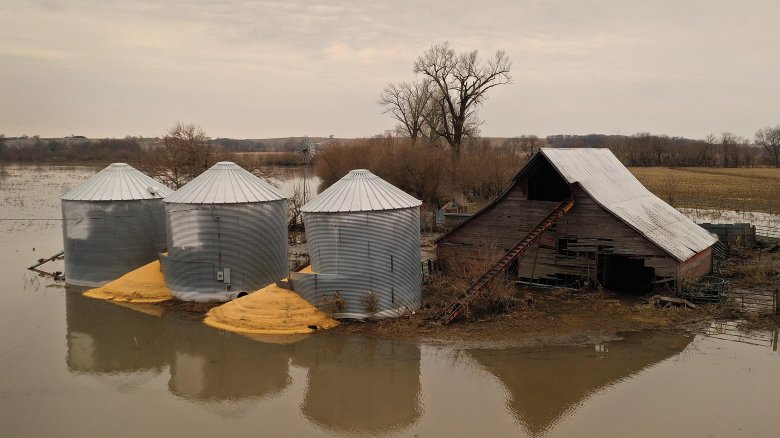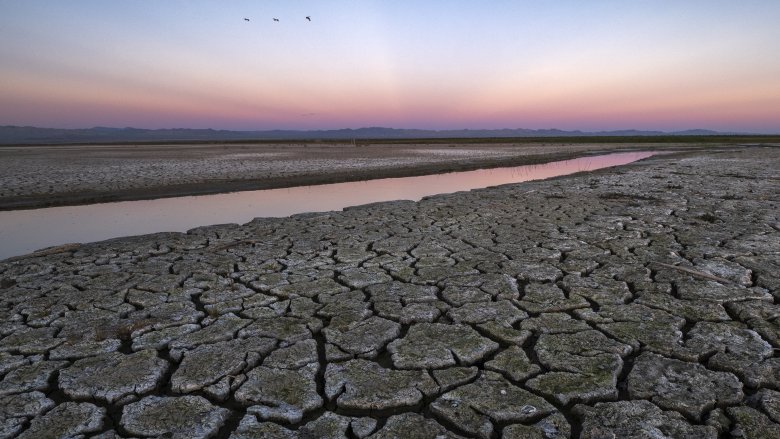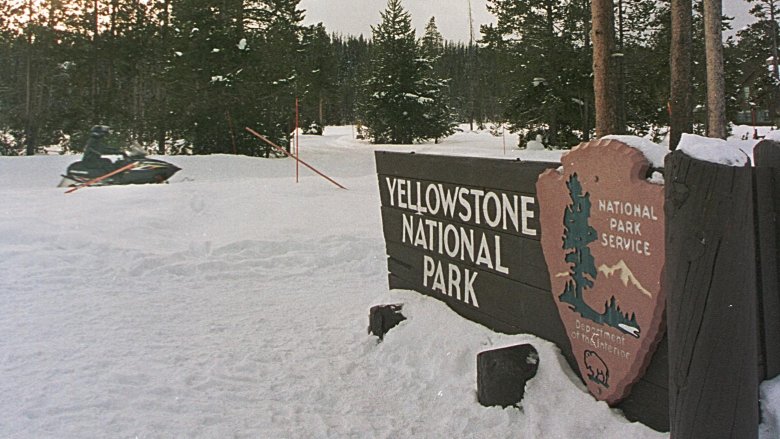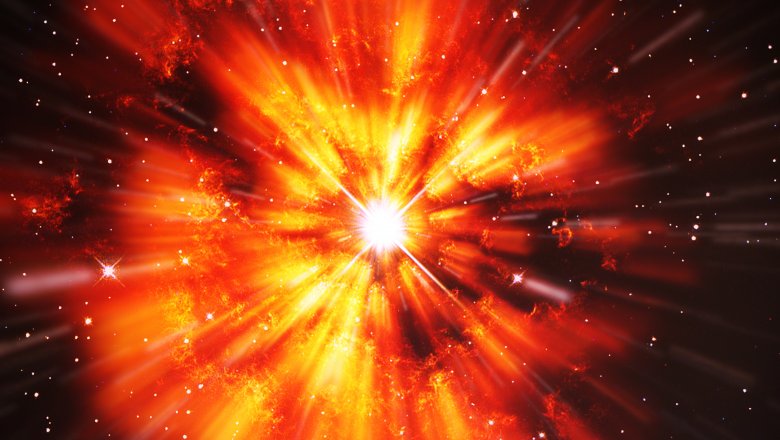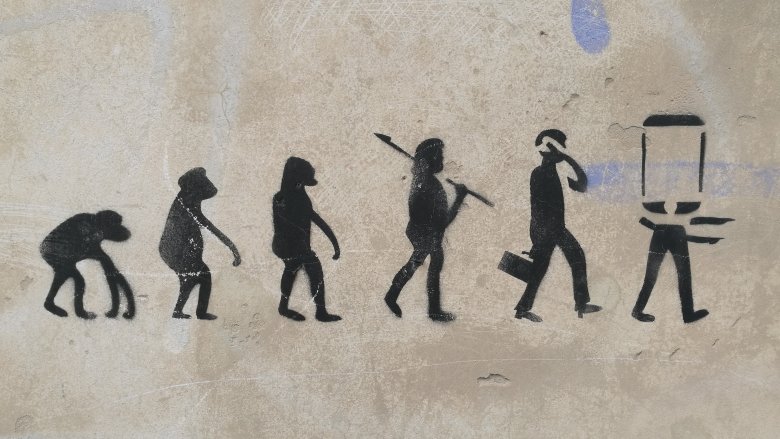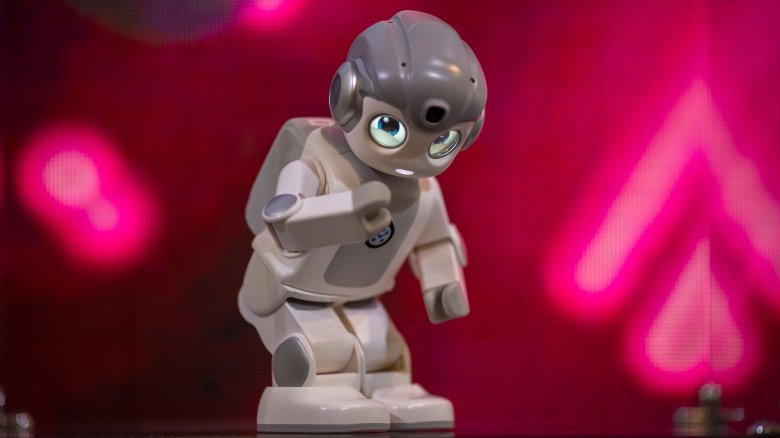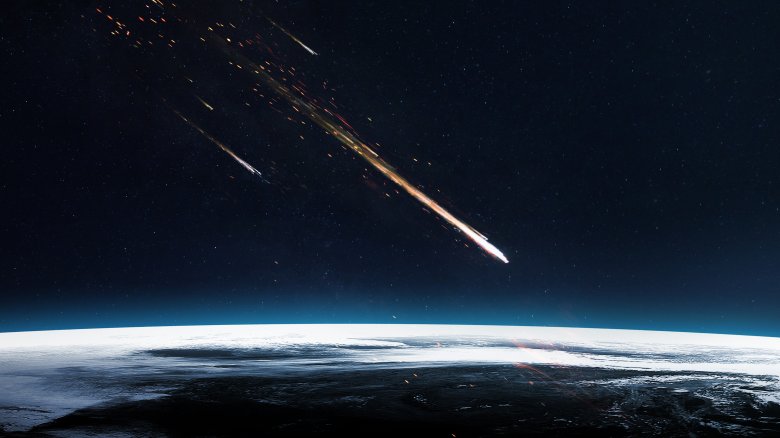The Most Likely Ways The Human Race Will End, According To Science
It's hard to get around it: We're probably all pretty screwed, and we don't know why. Sure, at an individual level, we've got things like heart disease, obesity, and car accidents to worry about, but from a wider perspective, we just can't know what will pound the final nail into humanity's collective coffin.
Still, we humans are nothing if not gamblers. We love prognosticating our own demise. Sometimes we do it in the form of a warning: "Change your ways or be doomed." Other times it's just the way televangelists stand out from the crowd, like the soothsaying apocalyptic version of wearing a particularly shiny paisley shirt to the club. Frequently, it's just cult leaders getting extra zany.
So what do the world's best and brightest say? Scientists have been trying to put a finger on how we're going to breathe our last since before they were called "scientists." Let's take a look at the strong odds, and whether or not there's any, you know, hope. Heads up, folks, possible spoilers ahead.
Nuclear annihilation (on purpose)
From Oppenheimer to Tom Lehrer, some of the most impressive brains of the last century have warned us that we're well on our way to blowing ourselves up. How will we know that the button press is around the corner? One method would be to check the Doomsday Clock.
The Doomsday Clock: It's not just for boosting DC's book sales anymore. Since 1947, the Bulletin of the Atomic Scientists has been tracking potential threats to humanity's existence via a metaphorical clock, with each progressive tick toward a world-ending "midnight" representing the threat of a more imminent potential conclusion to what scientists call "people." According to the physicists, biophysicists, diplomats, and inventors who contribute to the Bulletin, we've only ever come within "two minutes" of a world-ending nuclear disaster twice: once in 1953 when the U.S. and the Soviet Union started openly testing atomic weapons as a means of freaking each other out, and again right this (not metaphorical) minute.
Why so glum, expert chums? Well, with the United States' recent abandonment of the decades-old Intermediate-Range Nuclear Forces Treaty and also of the Iran Nuclear Deal, as well as major funding hikes to nuclear armament, maybe they're just a little skittish.
Nuclear annihilation (accidental)
Remember that time a pair of nukes dropped on North Carolina? Two bombs roughly 200 times more powerful than the ones used on Hiroshima and Nagasaki at the end of World War II? That's all right, it was sort of one of those funny little oopses that flies under the radar until the documents are released five decades later. So goofy!
It sounds like a wild internet conspiracy, but it's true. In 1961, an American B-52 bomber broke up while flying over Goldsboro, North Carolina. It then jettisoned its payload: two nuclear bombs. One bomb's parachute deployed, and it remained unarmed. The other one's didn't, it armed itself, and here's the really cool thing: Nobody is positive why it didn't detonate.
All this would be terrifying enough, but near-misses like this happen more often than you'd think. There was the 1980 Damascus Titan missile accident in which a missile silo in Arkansas exploded, or that time in 2007 when a pair of nuclear weapons just sort of went missing for a day and a half. And those are just a few of the ones we know about.
Combine the massive destructive force of atomic weapons with mankind's potential for giant screw-ups, and what do you get? The very real possibility an endgame scenario. An accident like any of these could activate America's computerized mutually assured destruction protocols, automatically launching thousands of missiles at Russia and triggering an apocalyptic, unintended exchange of enough bombs to effectively kill the planet.
Biological warfare
Who knows? Maybe we live up to the challenge of responsibly maintaining more nuclear weapons than there are Popeye's Chicken restaurants in the world. Maybe the safety measures put in place are enough to cover every nightmare scenario, and no terrorist cell or enraged dictatorship will ever start us on the path to Mad Max. Maybe the nukes will go un-nuked. But don't sleep soundly just yet because you know what's cheaper and more accessible than a mushroom cloud? An aerosol can full of sneeze and/or death.
Biological weapons are cheap, easy to produce, and nearly impossible to detect before the damage is done. In short, there's a reason that entire government office buildings shut down when there's so much as a hint of exposure to anthrax. But wait, it gets scarier. Experts say these untraceable death machines are getting even more accessible and dangerous with the rise of technology like the CRISPR gene editor. And they were already pretty bad before they could be custom-built. Joy.
Climate change
"Scientific evidence for warming of the climate system is unequivocal." That's a quote from the Intergovernmental Panel on Climate Change. Scientists agree: Earth's temperatures are rising, there's more carbon dioxide in the atmosphere than at any point in human history, and we might just be beyond repairing the damage.
Here's how it works. Greenhouse gases like CO2 and methane absorb heat from the Sun and reflect it back into the atmosphere, warming the planet. It's an observable fact that you can test for yourself at home. As humans release more and more of these gases into the air through industrialization and vehicles, the temperature continues to rise, changing the world in so, so many terrifying ways.
Permanent effects have already been documented. In 2016, scientists announced that a species of mammal had gone extinct due to climate change for the first time. The ice caps are melting, raising ocean levels to the point where cities like Venice are flooding, killing residents. As weather patterns become more extreme, entire areas of the world could become uninhabitable. Economies could collapse. Ecosystems could collapse. And according to NASA, it'll take decades, maybe even centuries to stop even if we stop producing CO2 right this minute.
Global pandemic
Maybe it's a little dour to pin all the potential end-of-days blame on human beings. After all, a deadly, highly contagious microscopic organism could sweep through mankind and we'd all die with a clean conscience.
Historically, the only thing that's killed more humans than humans has been disease. A few of the all-stars: the Black Death killed between one third and one half of everyone in Europe in the 14th century. The 1918 Spanish flu pandemic infected a third of the world and killed more than 50 million. AIDS has led to the deaths of at least 25 million.
The good news first: You'll notice that those numbers keep getting smaller with time. Our ability to confront and contain diseases gets better all the time. Now, the bad news. Diseases are getting better at fighting back. Overuse of antibiotics has made drug-resistant bacteria. Newer, more impressive strains of the flu come every year, and despite our remarkable advances, we still can't cure viral infections. The best we can do is treat the symptoms and boost the body's natural defenses while we wait for our immune systems to do the heavy lifting. Combine all these facts with the knowledge that an infected person can travel more easily across the ocean than ever before, and you'll understand why doctors would just love for you to get your flu shot.
Ecological collapse
Like Agent Smith pointed out in The Matrix, humans have a lot in common with viruses. We consume and adapt every environment where we see fit to set up camp, trashing pretty much everything in our field of view. In other words, maybe the real disease was us all along, and the friendships we made along the way.
Man's ability to eat up resources is unparalleled in nature, and that can mean the end of delicately balanced ecosystems. It can be seen today in the way we suck the life out of rain forests, or in the rapid decline in worldwide insect populations due to destruction of their natural habitats. Some scientists point to the collapse of ecosystems in the past as the beginning of a new epoch, dubbed the Anthropocene era, in which human actions such as deforestation and oil drilling caused more change more dramatically than any natural phenomenon in history. They posit that it could lead to worldwide biome instability.
That said, we've seen it happen before, and it hasn't always been our fault. Around 1000 B.C., a natural disaster near Iceland threw the northern hemisphere's environment into disarray, cooling temperatures and blocking out the Sun to the point where crops died out. What sort of event could trigger this on a global scale?
Yellowstone explodes
Yes, Yellowstone could explode. It probably won't, but hey. It could.
Yellowstone is home to roaming herds of bison, the Old Faithful geyser, and a supervolcano that, if it erupts, will make Michael Bay pack it in and start producing calming ASMR videos. Dubbed "The Yellowstone Caldera," it's ... upsettingly big. Bigger than you're thinking. Significantly larger than Manhattan. The crater stretches for 1,500 square miles.
What would happen if this puppy blew? Overreaction worst-case scenario, it could spew enough dust particles into the atmosphere that the air would become unbreathable. The Sun would be blotted from the sky. Plants would die off, ecosystems would crash, mass extinctions would rock the world. So take comfort in the fact that, despite the occasional tabloid claims to the contrary, Yellowstone isn't in danger of going up anytime soon, and even if it did, things likely wouldn't be that bad. Then take fear in the knowledge that there are two other supervolcanoes in the United States, an even bigger one in Indonesia, and over a dozen more around the globe.
Overpopulation
Disclaimer: People have been warning that cataclysmic overpopulation was just around the corner for thousands of years. Plato voiced concerns about it, and he lived on a planet with about 200 million people on it. And as much as people love making more people, the total human inhabitants of Earth stayed well under the 1 billion mark until the 1800s.
The thing is, as we approached the modern era, medicine improved. So did technology. Suddenly, things like disease and horrifying infant mortality rates weren't keeping us down the way they used to. Hitting 50 stopped being considered "old age." Birth rates skyrocketed, and grew exponentially. It took us 120 years to get from 1 billion to 2 billion, and only 32 years to get from 2 to 3 billion.
In 1999, Earth's population hit 6 billion. Twelve years later, It crossed 7 billion. With no new continents to colonize or imperialize, we're running out of places to put people and the resources to support them, although we have slowed way down on the growth. Still, it's part of why Stephen Hawking, in a speech given shortly before his death, stated that the move to other planets needed to happen soon.
Exploding stars
Like the oracles of old, let us look now to the stars for signs of our inevitable demise.
The idea of an exploding star is undeniably awesome and George Lucas-adjacent, but putting to one side the fact that we really have no way to stop the Sun from eventually engulfing the Earth like an unimaginably large Pac-Man eating a single dot that contains all of human history, you might think our humble planet is pretty safe from any damage them heavenly bodies might hold. Then along comes science to give you more night sweats.
Apparently, the dangers of a star going supernova aren't confined to planets with an up-close view. If it happened to a relatively close star, the Earth could be positively drenched with radiation in the form of gamma rays (the kind you might think would Hulk you out but would actually just kill you) and X-rays (the kind from the doctor's office that boil your skin if you don't use them correctly). The ozone could burn, or the nitrogen and oxygen in the air could ionize.
So how many stars are close enough to be concerning? That's the exciting part: We're not entirely sure, but probably a few hundred.
Rise of the posthumans
It's like that old thought experiment: You take a mop and replace the head. Then a little while later you replace the handle. Is this thing still the same mop? On a much more complex level, that's what people are starting to wonder about human beings.
Just like every other species on the planet, humans are the product of billions of years of evolution — small, almost imperceptible changes to the genetic code taking place over thousands of generations. But through the science of gene editing, we might not have to wait for our great-great-times-21-grandchildren to see what potential our bodies had in store. There's speculation that, with enough artificial changes to human DNA, we could create people that are not, strictly speaking, the same species as us. Smarter, better "posthumans" could replace us.
It might seem like alarmist sci-fi, but remember that, genetically, homo sapiens are only .004% different from neanderthals. It doesn't take much to tip the evolutionary scales.
Rise of the Machines
From Terminators to Ultron to Black Mirror, pop culture has been making humanity eat its robotic hubris vegetables for a while. And what have we learned? If all those Boston Dynamics videos are any indication, not much except for how to make scarier robots.
That said, Hollywood thrillers have never been the most accurate rubrics for potential disaster. Dinosaurs would be pretty easy to keep in cages if you really started small and stayed small, and snakes tend to find someplace warm and nap when you put them on a plane. To figure out how the rise of a super-intelligent new race of self-aware machines would change the world IRL, we turn to the expert researchers at the University of Cambridge's Center for the Study of Existential Risk. In an experiment that'll have you saying "that's what they do at Cambridge?" researchers modified the game Civilization V to simulate what would happen if artificial intelligence went uncontrolled. The results? Game over.
They're not the only ones that are concerned. Some of the world's biggest thinkers have warned us about the dangers of toying with machine consciousness. Bill Gates, Stephen Hawking, and Elon Musk have all spoken publicly about their worries, with some experts convinced that we'll experience the singularity by 2047.
Near Earth object strike
It's the biggest Ben Affleck-related long shot since "maybe he'll be the new Batman," but as history has shown us, crazy things just happen sometimes: Yes, the plot of Armageddon could slap humanity right across the face.
The threat of enormous space rocks has fascinated mankind since early humans first noticed that the sky just sort of throws stuff at you once in a while. That constant existential dread is what keeps astronomers ever vigilant, tracking thousands of near Earth objects at any given time.
Great big catastrophe collisions on par with the one that wiped out the dinosaurs can weigh heavily on a person's mind. That's part of why NASA formed the Planetary Defense Coordination Office, a team tasked with tracking comets and asteroids with the potential to cause devastating damage. The bummer news is that they think they've only found about a third of those so far, and that the information they do have wouldn't give us the ten-year window necessary to prepare a way to divert an incoming asteroid, or to raise the money to get Ben Affleck to do it.
